Business Finance Report: Financial Analysis, Cash Flow, and Budgeting
VerifiedAdded on 2023/01/18
|12
|3485
|77
Report
AI Summary
This report is a comprehensive analysis of business finance, divided into two parts. The first part delves into key financial terms such as profit, cash flow, working capital, receivables, payables, and inventory, explaining their significance and impact on financial results. It explores the effects of fluctuations in working capital on cash flows and provides an analysis of a case study involving Bright Lawns Limited, examining their profit, accounts receivable, accounts payable, and inventory. The report then recommends steps to improve cash flow, including effective inventory valuation, better control over small expenses, and timely payments to suppliers. The second part of the report focuses on budgeting, discussing the importance of budgets and traditional budgeting methods. It introduces alternative methods, such as rolling budgets, and analyzes the appropriateness of traditional versus alternative budgetary systems for businesses, using Boat World PLC as an example. The report aims to provide a detailed understanding of financial concepts and budgeting techniques.
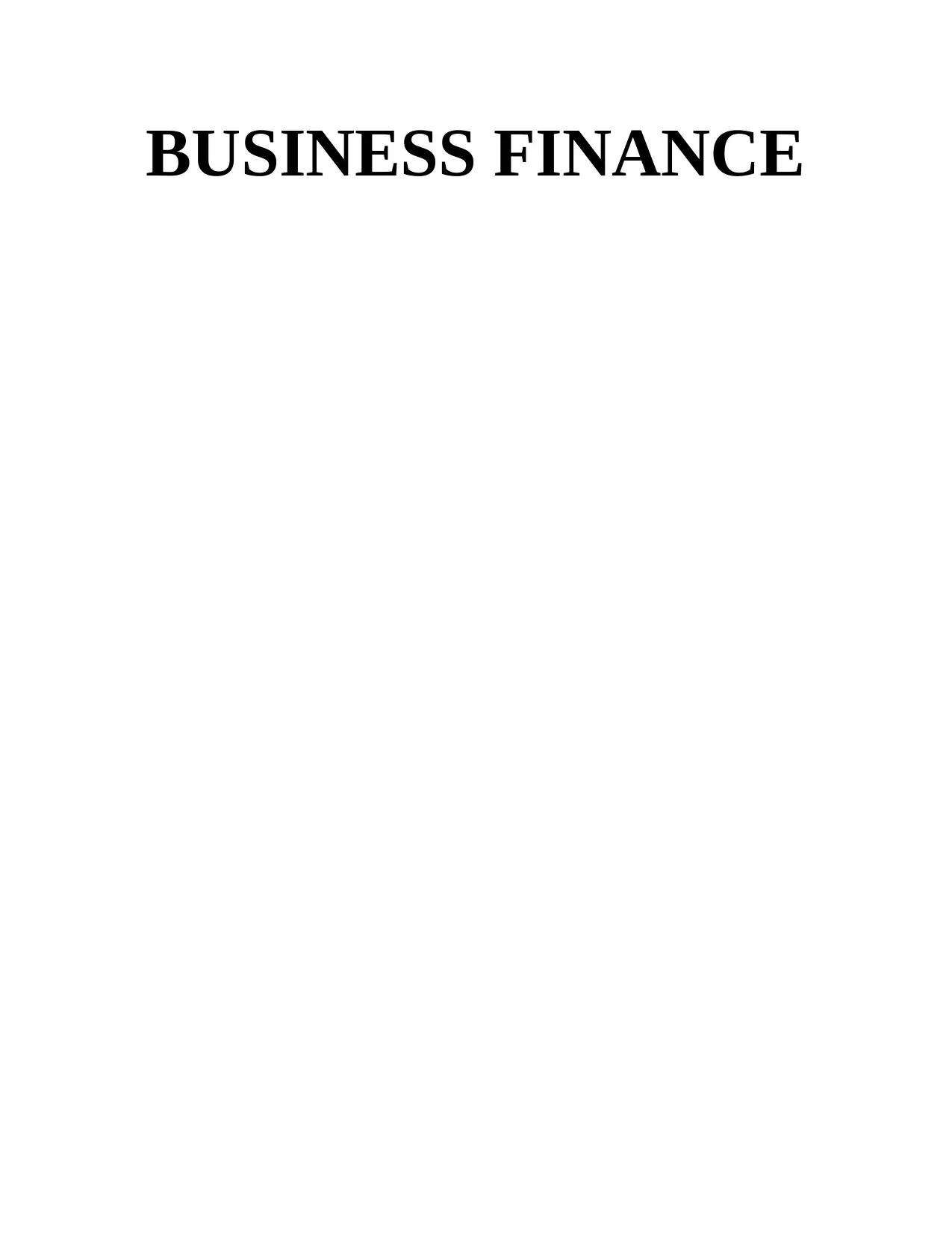
BUSINESS FINANCE
Paraphrase This Document
Need a fresh take? Get an instant paraphrase of this document with our AI Paraphraser
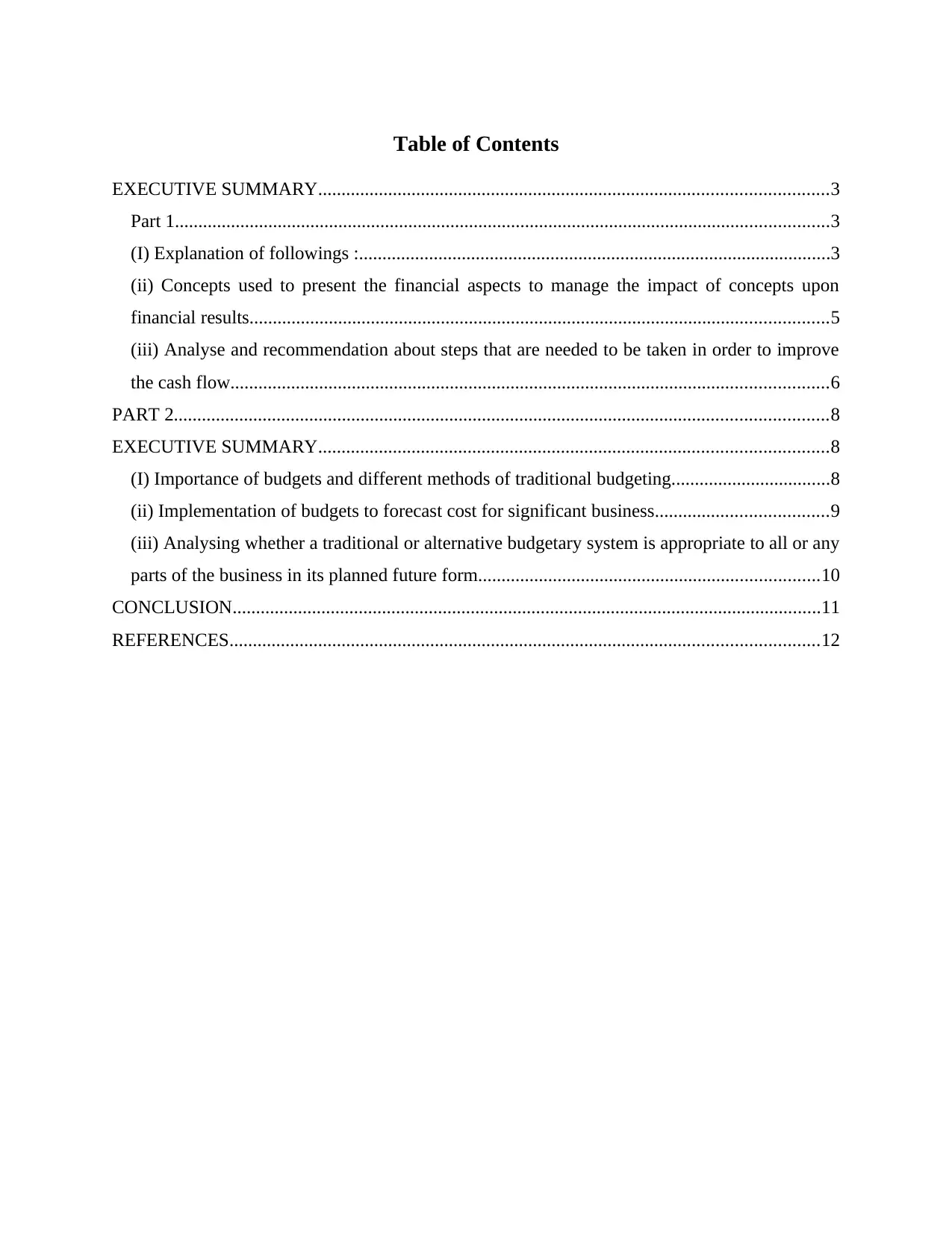
Table of Contents
EXECUTIVE SUMMARY.............................................................................................................3
Part 1............................................................................................................................................3
(I) Explanation of followings :.....................................................................................................3
(ii) Concepts used to present the financial aspects to manage the impact of concepts upon
financial results............................................................................................................................5
(iii) Analyse and recommendation about steps that are needed to be taken in order to improve
the cash flow................................................................................................................................6
PART 2............................................................................................................................................8
EXECUTIVE SUMMARY.............................................................................................................8
(I) Importance of budgets and different methods of traditional budgeting..................................8
(ii) Implementation of budgets to forecast cost for significant business.....................................9
(iii) Analysing whether a traditional or alternative budgetary system is appropriate to all or any
parts of the business in its planned future form.........................................................................10
CONCLUSION..............................................................................................................................11
REFERENCES..............................................................................................................................12
EXECUTIVE SUMMARY.............................................................................................................3
Part 1............................................................................................................................................3
(I) Explanation of followings :.....................................................................................................3
(ii) Concepts used to present the financial aspects to manage the impact of concepts upon
financial results............................................................................................................................5
(iii) Analyse and recommendation about steps that are needed to be taken in order to improve
the cash flow................................................................................................................................6
PART 2............................................................................................................................................8
EXECUTIVE SUMMARY.............................................................................................................8
(I) Importance of budgets and different methods of traditional budgeting..................................8
(ii) Implementation of budgets to forecast cost for significant business.....................................9
(iii) Analysing whether a traditional or alternative budgetary system is appropriate to all or any
parts of the business in its planned future form.........................................................................10
CONCLUSION..............................................................................................................................11
REFERENCES..............................................................................................................................12
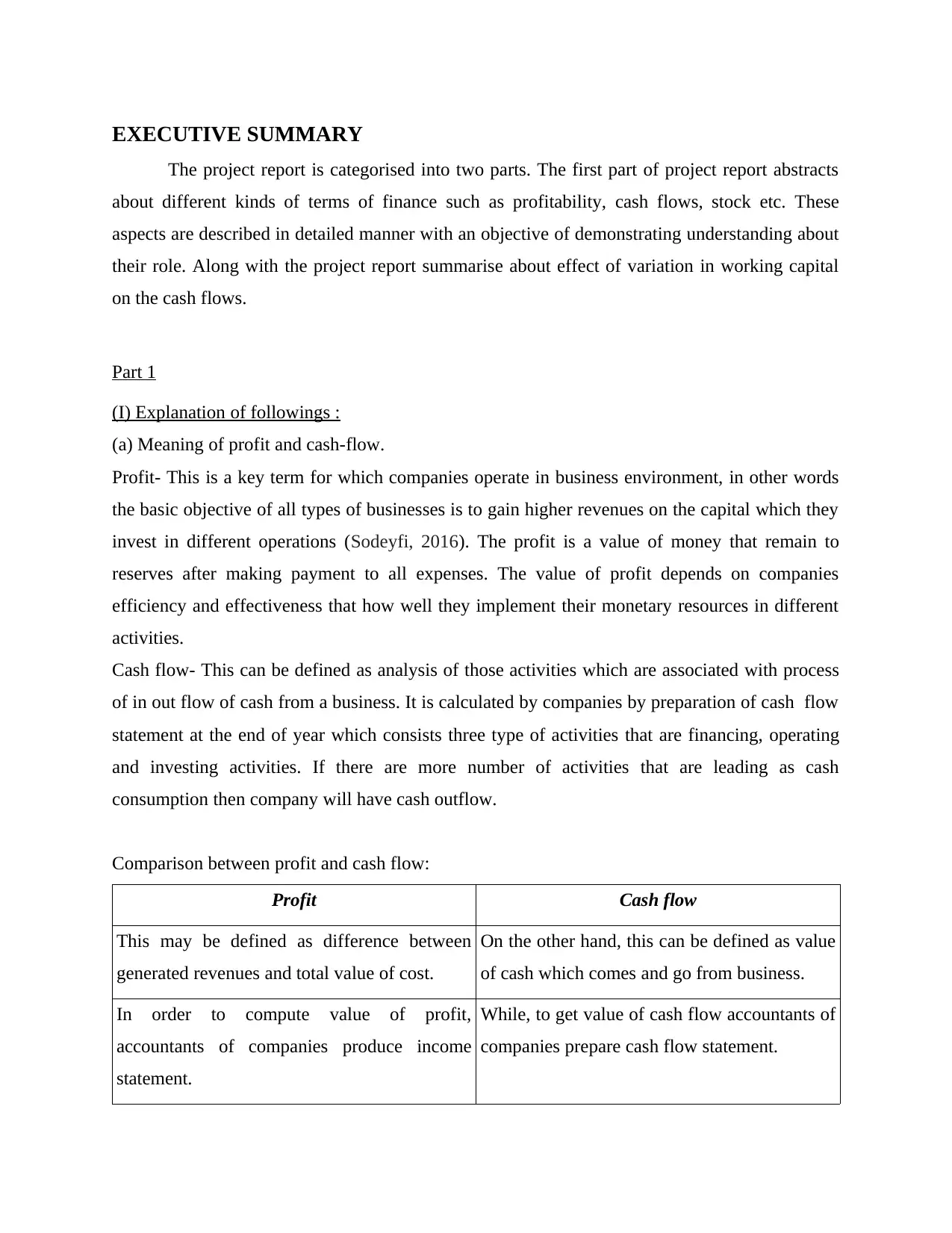
EXECUTIVE SUMMARY
The project report is categorised into two parts. The first part of project report abstracts
about different kinds of terms of finance such as profitability, cash flows, stock etc. These
aspects are described in detailed manner with an objective of demonstrating understanding about
their role. Along with the project report summarise about effect of variation in working capital
on the cash flows.
Part 1
(I) Explanation of followings :
(a) Meaning of profit and cash-flow.
Profit- This is a key term for which companies operate in business environment, in other words
the basic objective of all types of businesses is to gain higher revenues on the capital which they
invest in different operations (Sodeyfi, 2016). The profit is a value of money that remain to
reserves after making payment to all expenses. The value of profit depends on companies
efficiency and effectiveness that how well they implement their monetary resources in different
activities.
Cash flow- This can be defined as analysis of those activities which are associated with process
of in out flow of cash from a business. It is calculated by companies by preparation of cash flow
statement at the end of year which consists three type of activities that are financing, operating
and investing activities. If there are more number of activities that are leading as cash
consumption then company will have cash outflow.
Comparison between profit and cash flow:
Profit Cash flow
This may be defined as difference between
generated revenues and total value of cost.
On the other hand, this can be defined as value
of cash which comes and go from business.
In order to compute value of profit,
accountants of companies produce income
statement.
While, to get value of cash flow accountants of
companies prepare cash flow statement.
The project report is categorised into two parts. The first part of project report abstracts
about different kinds of terms of finance such as profitability, cash flows, stock etc. These
aspects are described in detailed manner with an objective of demonstrating understanding about
their role. Along with the project report summarise about effect of variation in working capital
on the cash flows.
Part 1
(I) Explanation of followings :
(a) Meaning of profit and cash-flow.
Profit- This is a key term for which companies operate in business environment, in other words
the basic objective of all types of businesses is to gain higher revenues on the capital which they
invest in different operations (Sodeyfi, 2016). The profit is a value of money that remain to
reserves after making payment to all expenses. The value of profit depends on companies
efficiency and effectiveness that how well they implement their monetary resources in different
activities.
Cash flow- This can be defined as analysis of those activities which are associated with process
of in out flow of cash from a business. It is calculated by companies by preparation of cash flow
statement at the end of year which consists three type of activities that are financing, operating
and investing activities. If there are more number of activities that are leading as cash
consumption then company will have cash outflow.
Comparison between profit and cash flow:
Profit Cash flow
This may be defined as difference between
generated revenues and total value of cost.
On the other hand, this can be defined as value
of cash which comes and go from business.
In order to compute value of profit,
accountants of companies produce income
statement.
While, to get value of cash flow accountants of
companies prepare cash flow statement.
⊘ This is a preview!⊘
Do you want full access?
Subscribe today to unlock all pages.

Trusted by 1+ million students worldwide
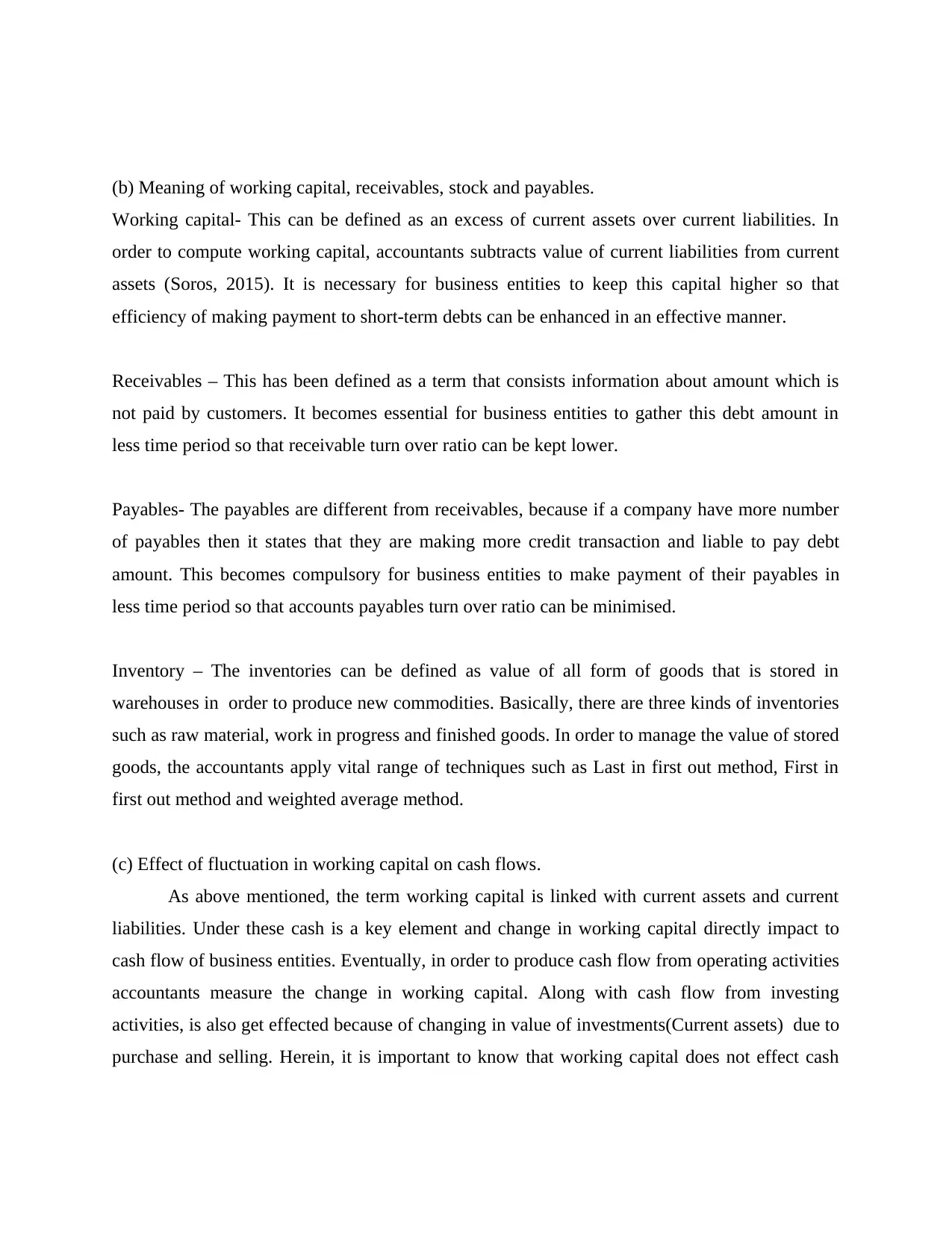
(b) Meaning of working capital, receivables, stock and payables.
Working capital- This can be defined as an excess of current assets over current liabilities. In
order to compute working capital, accountants subtracts value of current liabilities from current
assets (Soros, 2015). It is necessary for business entities to keep this capital higher so that
efficiency of making payment to short-term debts can be enhanced in an effective manner.
Receivables – This has been defined as a term that consists information about amount which is
not paid by customers. It becomes essential for business entities to gather this debt amount in
less time period so that receivable turn over ratio can be kept lower.
Payables- The payables are different from receivables, because if a company have more number
of payables then it states that they are making more credit transaction and liable to pay debt
amount. This becomes compulsory for business entities to make payment of their payables in
less time period so that accounts payables turn over ratio can be minimised.
Inventory – The inventories can be defined as value of all form of goods that is stored in
warehouses in order to produce new commodities. Basically, there are three kinds of inventories
such as raw material, work in progress and finished goods. In order to manage the value of stored
goods, the accountants apply vital range of techniques such as Last in first out method, First in
first out method and weighted average method.
(c) Effect of fluctuation in working capital on cash flows.
As above mentioned, the term working capital is linked with current assets and current
liabilities. Under these cash is a key element and change in working capital directly impact to
cash flow of business entities. Eventually, in order to produce cash flow from operating activities
accountants measure the change in working capital. Along with cash flow from investing
activities, is also get effected because of changing in value of investments(Current assets) due to
purchase and selling. Herein, it is important to know that working capital does not effect cash
Working capital- This can be defined as an excess of current assets over current liabilities. In
order to compute working capital, accountants subtracts value of current liabilities from current
assets (Soros, 2015). It is necessary for business entities to keep this capital higher so that
efficiency of making payment to short-term debts can be enhanced in an effective manner.
Receivables – This has been defined as a term that consists information about amount which is
not paid by customers. It becomes essential for business entities to gather this debt amount in
less time period so that receivable turn over ratio can be kept lower.
Payables- The payables are different from receivables, because if a company have more number
of payables then it states that they are making more credit transaction and liable to pay debt
amount. This becomes compulsory for business entities to make payment of their payables in
less time period so that accounts payables turn over ratio can be minimised.
Inventory – The inventories can be defined as value of all form of goods that is stored in
warehouses in order to produce new commodities. Basically, there are three kinds of inventories
such as raw material, work in progress and finished goods. In order to manage the value of stored
goods, the accountants apply vital range of techniques such as Last in first out method, First in
first out method and weighted average method.
(c) Effect of fluctuation in working capital on cash flows.
As above mentioned, the term working capital is linked with current assets and current
liabilities. Under these cash is a key element and change in working capital directly impact to
cash flow of business entities. Eventually, in order to produce cash flow from operating activities
accountants measure the change in working capital. Along with cash flow from investing
activities, is also get effected because of changing in value of investments(Current assets) due to
purchase and selling. Herein, it is important to know that working capital does not effect cash
Paraphrase This Document
Need a fresh take? Get an instant paraphrase of this document with our AI Paraphraser
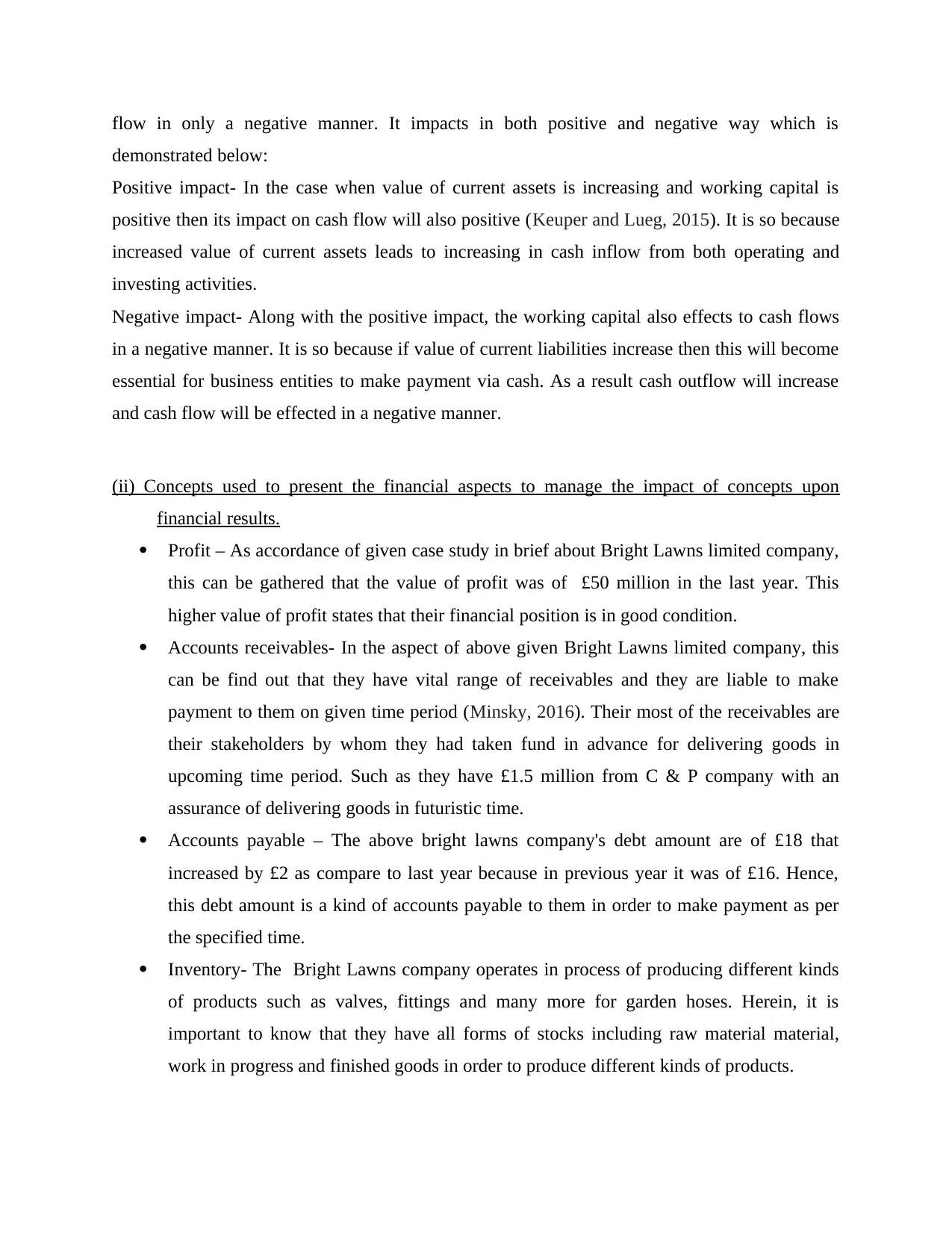
flow in only a negative manner. It impacts in both positive and negative way which is
demonstrated below:
Positive impact- In the case when value of current assets is increasing and working capital is
positive then its impact on cash flow will also positive (Keuper and Lueg, 2015). It is so because
increased value of current assets leads to increasing in cash inflow from both operating and
investing activities.
Negative impact- Along with the positive impact, the working capital also effects to cash flows
in a negative manner. It is so because if value of current liabilities increase then this will become
essential for business entities to make payment via cash. As a result cash outflow will increase
and cash flow will be effected in a negative manner.
(ii) Concepts used to present the financial aspects to manage the impact of concepts upon
financial results.
Profit – As accordance of given case study in brief about Bright Lawns limited company,
this can be gathered that the value of profit was of £50 million in the last year. This
higher value of profit states that their financial position is in good condition.
Accounts receivables- In the aspect of above given Bright Lawns limited company, this
can be find out that they have vital range of receivables and they are liable to make
payment to them on given time period (Minsky, 2016). Their most of the receivables are
their stakeholders by whom they had taken fund in advance for delivering goods in
upcoming time period. Such as they have £1.5 million from C & P company with an
assurance of delivering goods in futuristic time.
Accounts payable – The above bright lawns company's debt amount are of £18 that
increased by £2 as compare to last year because in previous year it was of £16. Hence,
this debt amount is a kind of accounts payable to them in order to make payment as per
the specified time.
Inventory- The Bright Lawns company operates in process of producing different kinds
of products such as valves, fittings and many more for garden hoses. Herein, it is
important to know that they have all forms of stocks including raw material material,
work in progress and finished goods in order to produce different kinds of products.
demonstrated below:
Positive impact- In the case when value of current assets is increasing and working capital is
positive then its impact on cash flow will also positive (Keuper and Lueg, 2015). It is so because
increased value of current assets leads to increasing in cash inflow from both operating and
investing activities.
Negative impact- Along with the positive impact, the working capital also effects to cash flows
in a negative manner. It is so because if value of current liabilities increase then this will become
essential for business entities to make payment via cash. As a result cash outflow will increase
and cash flow will be effected in a negative manner.
(ii) Concepts used to present the financial aspects to manage the impact of concepts upon
financial results.
Profit – As accordance of given case study in brief about Bright Lawns limited company,
this can be gathered that the value of profit was of £50 million in the last year. This
higher value of profit states that their financial position is in good condition.
Accounts receivables- In the aspect of above given Bright Lawns limited company, this
can be find out that they have vital range of receivables and they are liable to make
payment to them on given time period (Minsky, 2016). Their most of the receivables are
their stakeholders by whom they had taken fund in advance for delivering goods in
upcoming time period. Such as they have £1.5 million from C & P company with an
assurance of delivering goods in futuristic time.
Accounts payable – The above bright lawns company's debt amount are of £18 that
increased by £2 as compare to last year because in previous year it was of £16. Hence,
this debt amount is a kind of accounts payable to them in order to make payment as per
the specified time.
Inventory- The Bright Lawns company operates in process of producing different kinds
of products such as valves, fittings and many more for garden hoses. Herein, it is
important to know that they have all forms of stocks including raw material material,
work in progress and finished goods in order to produce different kinds of products.
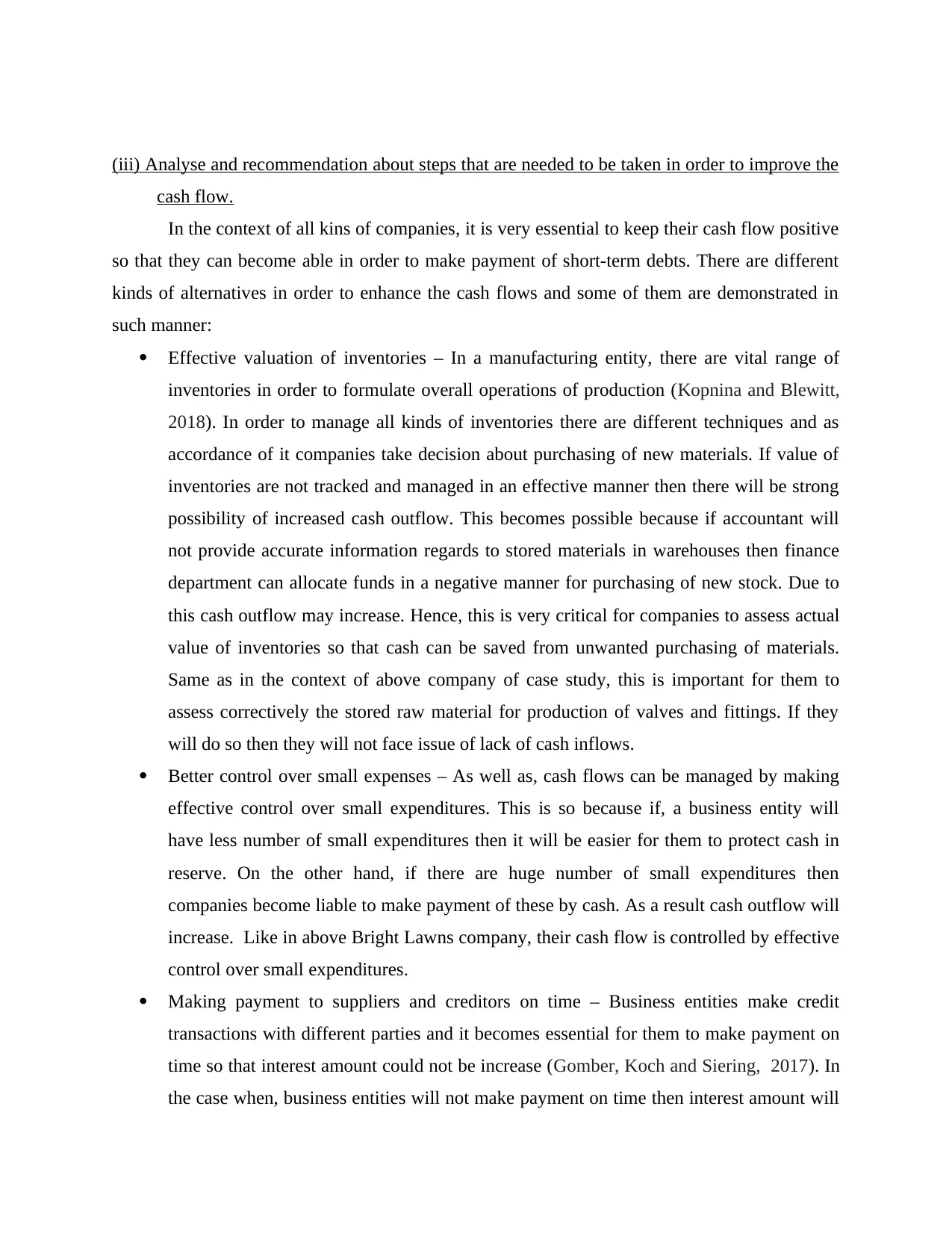
(iii) Analyse and recommendation about steps that are needed to be taken in order to improve the
cash flow.
In the context of all kins of companies, it is very essential to keep their cash flow positive
so that they can become able in order to make payment of short-term debts. There are different
kinds of alternatives in order to enhance the cash flows and some of them are demonstrated in
such manner:
Effective valuation of inventories – In a manufacturing entity, there are vital range of
inventories in order to formulate overall operations of production (Kopnina and Blewitt,
2018). In order to manage all kinds of inventories there are different techniques and as
accordance of it companies take decision about purchasing of new materials. If value of
inventories are not tracked and managed in an effective manner then there will be strong
possibility of increased cash outflow. This becomes possible because if accountant will
not provide accurate information regards to stored materials in warehouses then finance
department can allocate funds in a negative manner for purchasing of new stock. Due to
this cash outflow may increase. Hence, this is very critical for companies to assess actual
value of inventories so that cash can be saved from unwanted purchasing of materials.
Same as in the context of above company of case study, this is important for them to
assess correctively the stored raw material for production of valves and fittings. If they
will do so then they will not face issue of lack of cash inflows.
Better control over small expenses – As well as, cash flows can be managed by making
effective control over small expenditures. This is so because if, a business entity will
have less number of small expenditures then it will be easier for them to protect cash in
reserve. On the other hand, if there are huge number of small expenditures then
companies become liable to make payment of these by cash. As a result cash outflow will
increase. Like in above Bright Lawns company, their cash flow is controlled by effective
control over small expenditures.
Making payment to suppliers and creditors on time – Business entities make credit
transactions with different parties and it becomes essential for them to make payment on
time so that interest amount could not be increase (Gomber, Koch and Siering, 2017). In
the case when, business entities will not make payment on time then interest amount will
cash flow.
In the context of all kins of companies, it is very essential to keep their cash flow positive
so that they can become able in order to make payment of short-term debts. There are different
kinds of alternatives in order to enhance the cash flows and some of them are demonstrated in
such manner:
Effective valuation of inventories – In a manufacturing entity, there are vital range of
inventories in order to formulate overall operations of production (Kopnina and Blewitt,
2018). In order to manage all kinds of inventories there are different techniques and as
accordance of it companies take decision about purchasing of new materials. If value of
inventories are not tracked and managed in an effective manner then there will be strong
possibility of increased cash outflow. This becomes possible because if accountant will
not provide accurate information regards to stored materials in warehouses then finance
department can allocate funds in a negative manner for purchasing of new stock. Due to
this cash outflow may increase. Hence, this is very critical for companies to assess actual
value of inventories so that cash can be saved from unwanted purchasing of materials.
Same as in the context of above company of case study, this is important for them to
assess correctively the stored raw material for production of valves and fittings. If they
will do so then they will not face issue of lack of cash inflows.
Better control over small expenses – As well as, cash flows can be managed by making
effective control over small expenditures. This is so because if, a business entity will
have less number of small expenditures then it will be easier for them to protect cash in
reserve. On the other hand, if there are huge number of small expenditures then
companies become liable to make payment of these by cash. As a result cash outflow will
increase. Like in above Bright Lawns company, their cash flow is controlled by effective
control over small expenditures.
Making payment to suppliers and creditors on time – Business entities make credit
transactions with different parties and it becomes essential for them to make payment on
time so that interest amount could not be increase (Gomber, Koch and Siering, 2017). In
the case when, business entities will not make payment on time then interest amount will
⊘ This is a preview!⊘
Do you want full access?
Subscribe today to unlock all pages.

Trusted by 1+ million students worldwide
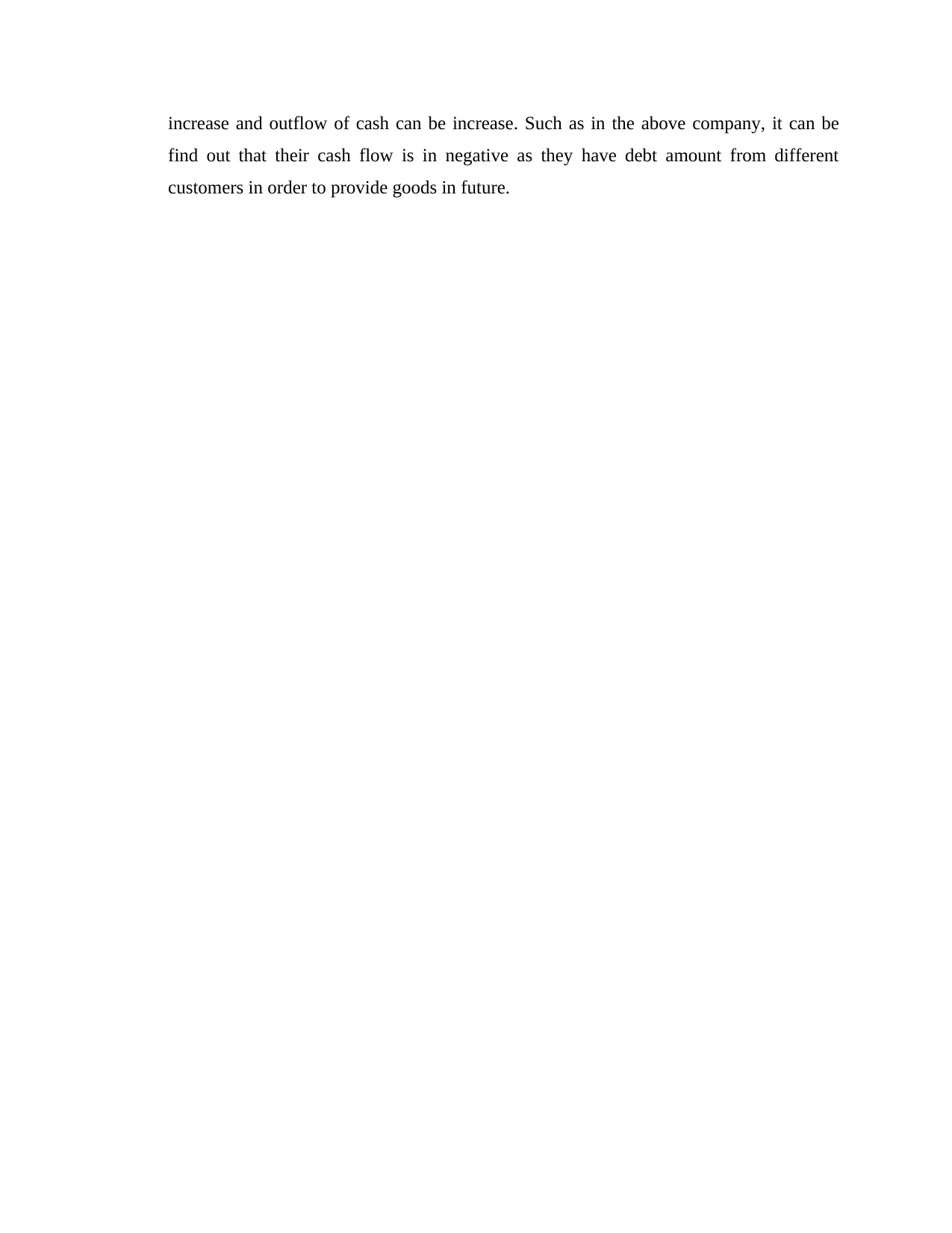
increase and outflow of cash can be increase. Such as in the above company, it can be
find out that their cash flow is in negative as they have debt amount from different
customers in order to provide goods in future.
find out that their cash flow is in negative as they have debt amount from different
customers in order to provide goods in future.
Paraphrase This Document
Need a fresh take? Get an instant paraphrase of this document with our AI Paraphraser
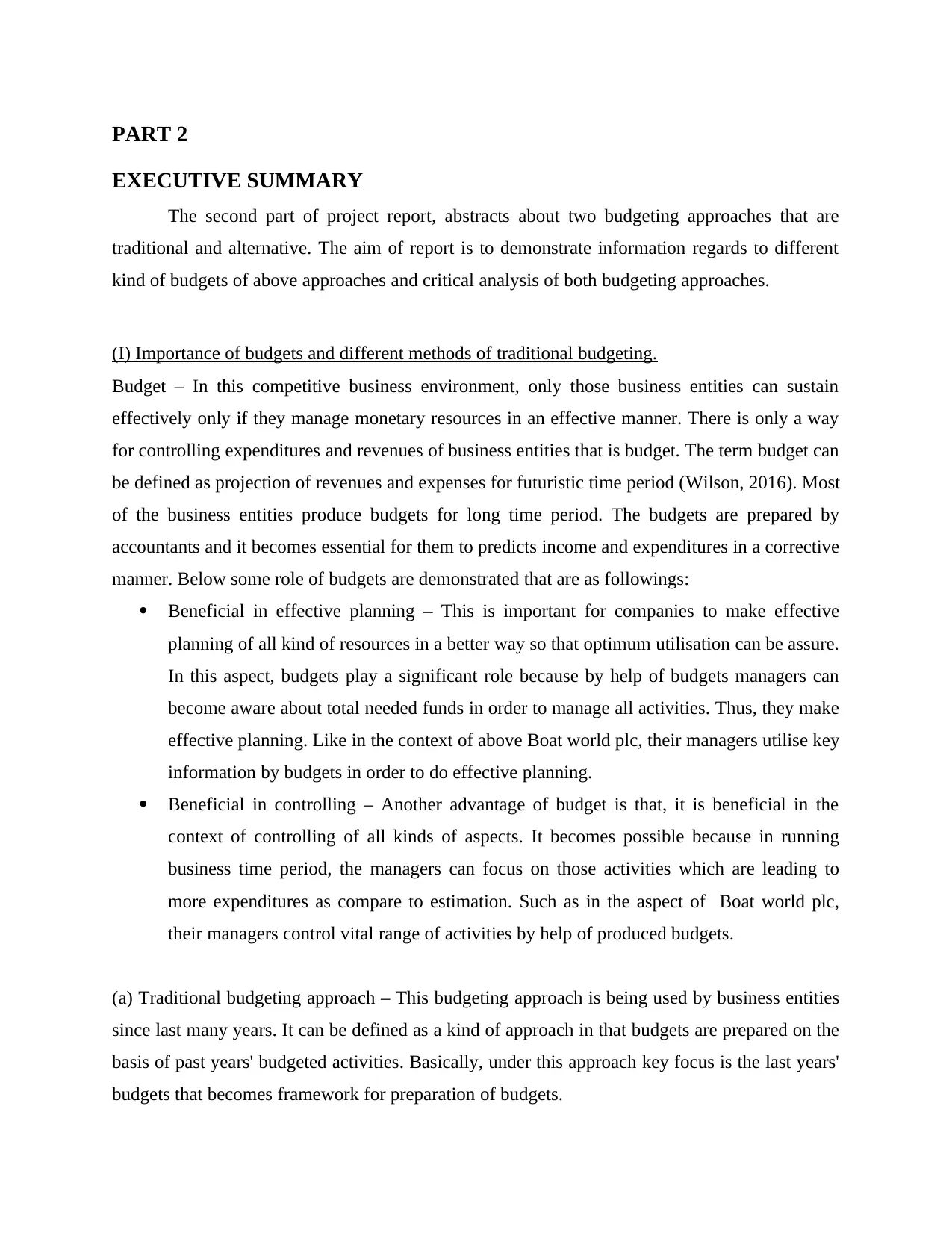
PART 2
EXECUTIVE SUMMARY
The second part of project report, abstracts about two budgeting approaches that are
traditional and alternative. The aim of report is to demonstrate information regards to different
kind of budgets of above approaches and critical analysis of both budgeting approaches.
(I) Importance of budgets and different methods of traditional budgeting.
Budget – In this competitive business environment, only those business entities can sustain
effectively only if they manage monetary resources in an effective manner. There is only a way
for controlling expenditures and revenues of business entities that is budget. The term budget can
be defined as projection of revenues and expenses for futuristic time period (Wilson, 2016). Most
of the business entities produce budgets for long time period. The budgets are prepared by
accountants and it becomes essential for them to predicts income and expenditures in a corrective
manner. Below some role of budgets are demonstrated that are as followings:
Beneficial in effective planning – This is important for companies to make effective
planning of all kind of resources in a better way so that optimum utilisation can be assure.
In this aspect, budgets play a significant role because by help of budgets managers can
become aware about total needed funds in order to manage all activities. Thus, they make
effective planning. Like in the context of above Boat world plc, their managers utilise key
information by budgets in order to do effective planning.
Beneficial in controlling – Another advantage of budget is that, it is beneficial in the
context of controlling of all kinds of aspects. It becomes possible because in running
business time period, the managers can focus on those activities which are leading to
more expenditures as compare to estimation. Such as in the aspect of Boat world plc,
their managers control vital range of activities by help of produced budgets.
(a) Traditional budgeting approach – This budgeting approach is being used by business entities
since last many years. It can be defined as a kind of approach in that budgets are prepared on the
basis of past years' budgeted activities. Basically, under this approach key focus is the last years'
budgets that becomes framework for preparation of budgets.
EXECUTIVE SUMMARY
The second part of project report, abstracts about two budgeting approaches that are
traditional and alternative. The aim of report is to demonstrate information regards to different
kind of budgets of above approaches and critical analysis of both budgeting approaches.
(I) Importance of budgets and different methods of traditional budgeting.
Budget – In this competitive business environment, only those business entities can sustain
effectively only if they manage monetary resources in an effective manner. There is only a way
for controlling expenditures and revenues of business entities that is budget. The term budget can
be defined as projection of revenues and expenses for futuristic time period (Wilson, 2016). Most
of the business entities produce budgets for long time period. The budgets are prepared by
accountants and it becomes essential for them to predicts income and expenditures in a corrective
manner. Below some role of budgets are demonstrated that are as followings:
Beneficial in effective planning – This is important for companies to make effective
planning of all kind of resources in a better way so that optimum utilisation can be assure.
In this aspect, budgets play a significant role because by help of budgets managers can
become aware about total needed funds in order to manage all activities. Thus, they make
effective planning. Like in the context of above Boat world plc, their managers utilise key
information by budgets in order to do effective planning.
Beneficial in controlling – Another advantage of budget is that, it is beneficial in the
context of controlling of all kinds of aspects. It becomes possible because in running
business time period, the managers can focus on those activities which are leading to
more expenditures as compare to estimation. Such as in the aspect of Boat world plc,
their managers control vital range of activities by help of produced budgets.
(a) Traditional budgeting approach – This budgeting approach is being used by business entities
since last many years. It can be defined as a kind of approach in that budgets are prepared on the
basis of past years' budgeted activities. Basically, under this approach key focus is the last years'
budgets that becomes framework for preparation of budgets.
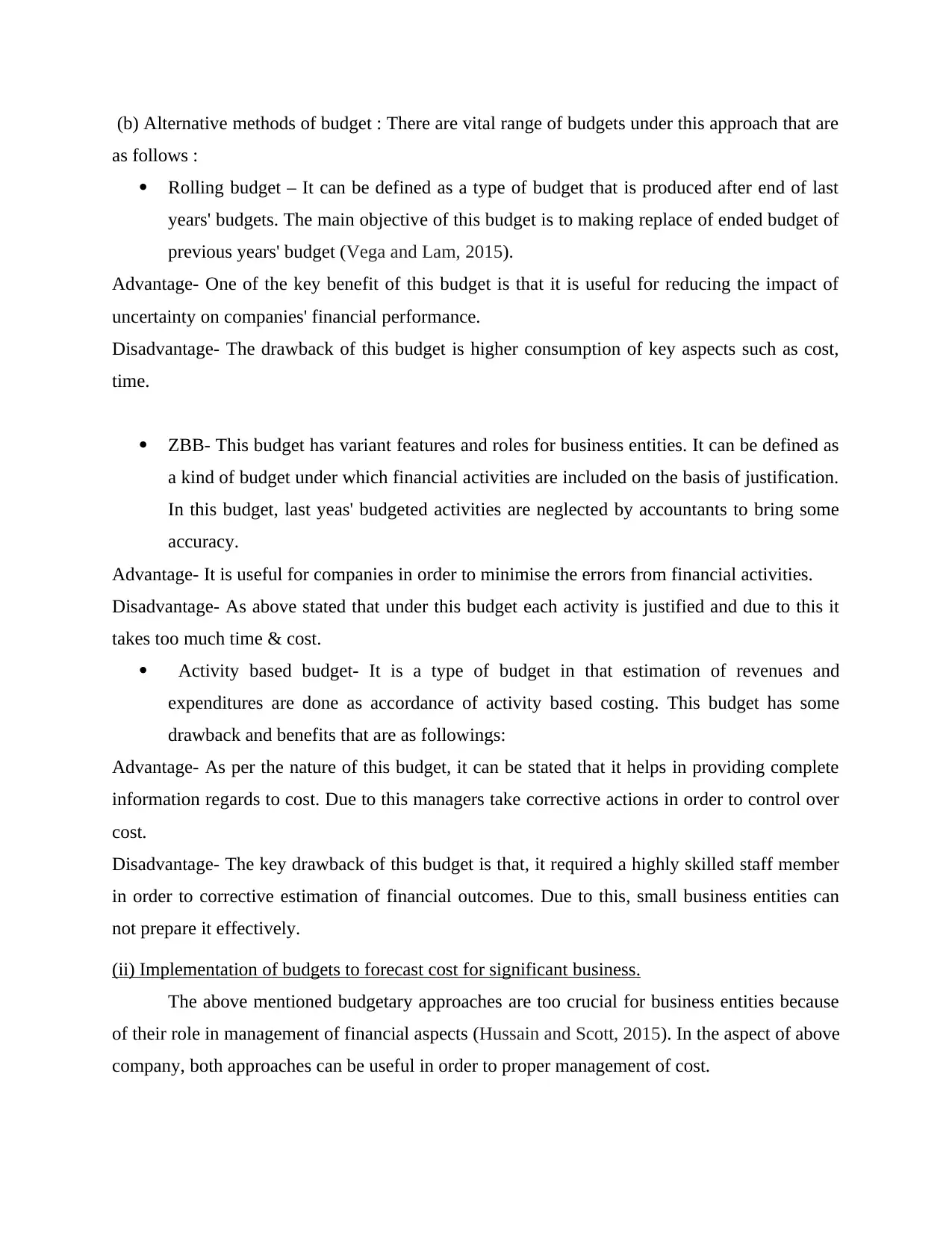
(b) Alternative methods of budget : There are vital range of budgets under this approach that are
as follows :
Rolling budget – It can be defined as a type of budget that is produced after end of last
years' budgets. The main objective of this budget is to making replace of ended budget of
previous years' budget (Vega and Lam, 2015).
Advantage- One of the key benefit of this budget is that it is useful for reducing the impact of
uncertainty on companies' financial performance.
Disadvantage- The drawback of this budget is higher consumption of key aspects such as cost,
time.
ZBB- This budget has variant features and roles for business entities. It can be defined as
a kind of budget under which financial activities are included on the basis of justification.
In this budget, last yeas' budgeted activities are neglected by accountants to bring some
accuracy.
Advantage- It is useful for companies in order to minimise the errors from financial activities.
Disadvantage- As above stated that under this budget each activity is justified and due to this it
takes too much time & cost.
Activity based budget- It is a type of budget in that estimation of revenues and
expenditures are done as accordance of activity based costing. This budget has some
drawback and benefits that are as followings:
Advantage- As per the nature of this budget, it can be stated that it helps in providing complete
information regards to cost. Due to this managers take corrective actions in order to control over
cost.
Disadvantage- The key drawback of this budget is that, it required a highly skilled staff member
in order to corrective estimation of financial outcomes. Due to this, small business entities can
not prepare it effectively.
(ii) Implementation of budgets to forecast cost for significant business.
The above mentioned budgetary approaches are too crucial for business entities because
of their role in management of financial aspects (Hussain and Scott, 2015). In the aspect of above
company, both approaches can be useful in order to proper management of cost.
as follows :
Rolling budget – It can be defined as a type of budget that is produced after end of last
years' budgets. The main objective of this budget is to making replace of ended budget of
previous years' budget (Vega and Lam, 2015).
Advantage- One of the key benefit of this budget is that it is useful for reducing the impact of
uncertainty on companies' financial performance.
Disadvantage- The drawback of this budget is higher consumption of key aspects such as cost,
time.
ZBB- This budget has variant features and roles for business entities. It can be defined as
a kind of budget under which financial activities are included on the basis of justification.
In this budget, last yeas' budgeted activities are neglected by accountants to bring some
accuracy.
Advantage- It is useful for companies in order to minimise the errors from financial activities.
Disadvantage- As above stated that under this budget each activity is justified and due to this it
takes too much time & cost.
Activity based budget- It is a type of budget in that estimation of revenues and
expenditures are done as accordance of activity based costing. This budget has some
drawback and benefits that are as followings:
Advantage- As per the nature of this budget, it can be stated that it helps in providing complete
information regards to cost. Due to this managers take corrective actions in order to control over
cost.
Disadvantage- The key drawback of this budget is that, it required a highly skilled staff member
in order to corrective estimation of financial outcomes. Due to this, small business entities can
not prepare it effectively.
(ii) Implementation of budgets to forecast cost for significant business.
The above mentioned budgetary approaches are too crucial for business entities because
of their role in management of financial aspects (Hussain and Scott, 2015). In the aspect of above
company, both approaches can be useful in order to proper management of cost.
⊘ This is a preview!⊘
Do you want full access?
Subscribe today to unlock all pages.

Trusted by 1+ million students worldwide
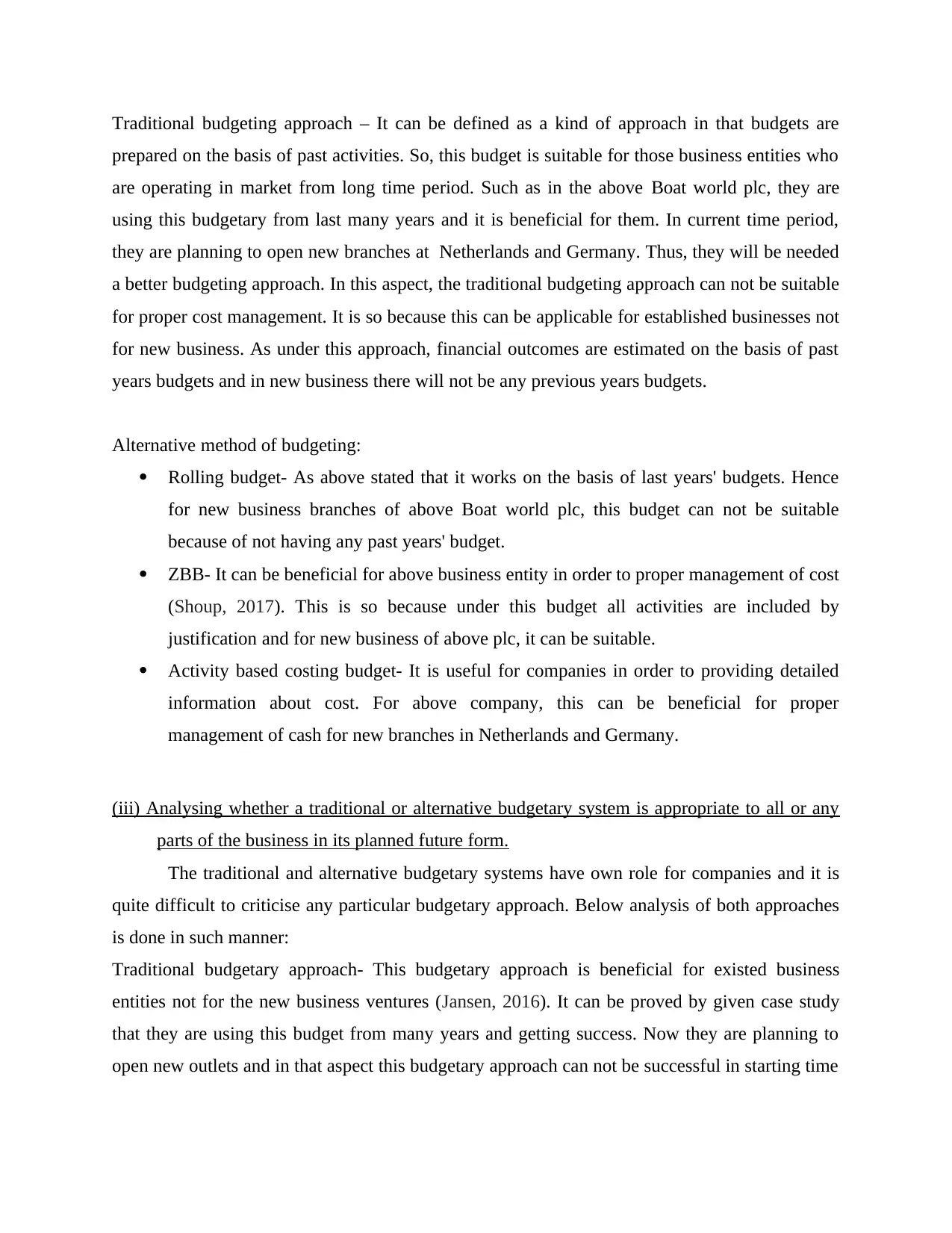
Traditional budgeting approach – It can be defined as a kind of approach in that budgets are
prepared on the basis of past activities. So, this budget is suitable for those business entities who
are operating in market from long time period. Such as in the above Boat world plc, they are
using this budgetary from last many years and it is beneficial for them. In current time period,
they are planning to open new branches at Netherlands and Germany. Thus, they will be needed
a better budgeting approach. In this aspect, the traditional budgeting approach can not be suitable
for proper cost management. It is so because this can be applicable for established businesses not
for new business. As under this approach, financial outcomes are estimated on the basis of past
years budgets and in new business there will not be any previous years budgets.
Alternative method of budgeting:
Rolling budget- As above stated that it works on the basis of last years' budgets. Hence
for new business branches of above Boat world plc, this budget can not be suitable
because of not having any past years' budget.
ZBB- It can be beneficial for above business entity in order to proper management of cost
(Shoup, 2017). This is so because under this budget all activities are included by
justification and for new business of above plc, it can be suitable.
Activity based costing budget- It is useful for companies in order to providing detailed
information about cost. For above company, this can be beneficial for proper
management of cash for new branches in Netherlands and Germany.
(iii) Analysing whether a traditional or alternative budgetary system is appropriate to all or any
parts of the business in its planned future form.
The traditional and alternative budgetary systems have own role for companies and it is
quite difficult to criticise any particular budgetary approach. Below analysis of both approaches
is done in such manner:
Traditional budgetary approach- This budgetary approach is beneficial for existed business
entities not for the new business ventures (Jansen, 2016). It can be proved by given case study
that they are using this budget from many years and getting success. Now they are planning to
open new outlets and in that aspect this budgetary approach can not be successful in starting time
prepared on the basis of past activities. So, this budget is suitable for those business entities who
are operating in market from long time period. Such as in the above Boat world plc, they are
using this budgetary from last many years and it is beneficial for them. In current time period,
they are planning to open new branches at Netherlands and Germany. Thus, they will be needed
a better budgeting approach. In this aspect, the traditional budgeting approach can not be suitable
for proper cost management. It is so because this can be applicable for established businesses not
for new business. As under this approach, financial outcomes are estimated on the basis of past
years budgets and in new business there will not be any previous years budgets.
Alternative method of budgeting:
Rolling budget- As above stated that it works on the basis of last years' budgets. Hence
for new business branches of above Boat world plc, this budget can not be suitable
because of not having any past years' budget.
ZBB- It can be beneficial for above business entity in order to proper management of cost
(Shoup, 2017). This is so because under this budget all activities are included by
justification and for new business of above plc, it can be suitable.
Activity based costing budget- It is useful for companies in order to providing detailed
information about cost. For above company, this can be beneficial for proper
management of cash for new branches in Netherlands and Germany.
(iii) Analysing whether a traditional or alternative budgetary system is appropriate to all or any
parts of the business in its planned future form.
The traditional and alternative budgetary systems have own role for companies and it is
quite difficult to criticise any particular budgetary approach. Below analysis of both approaches
is done in such manner:
Traditional budgetary approach- This budgetary approach is beneficial for existed business
entities not for the new business ventures (Jansen, 2016). It can be proved by given case study
that they are using this budget from many years and getting success. Now they are planning to
open new outlets and in that aspect this budgetary approach can not be successful in starting time
Paraphrase This Document
Need a fresh take? Get an instant paraphrase of this document with our AI Paraphraser
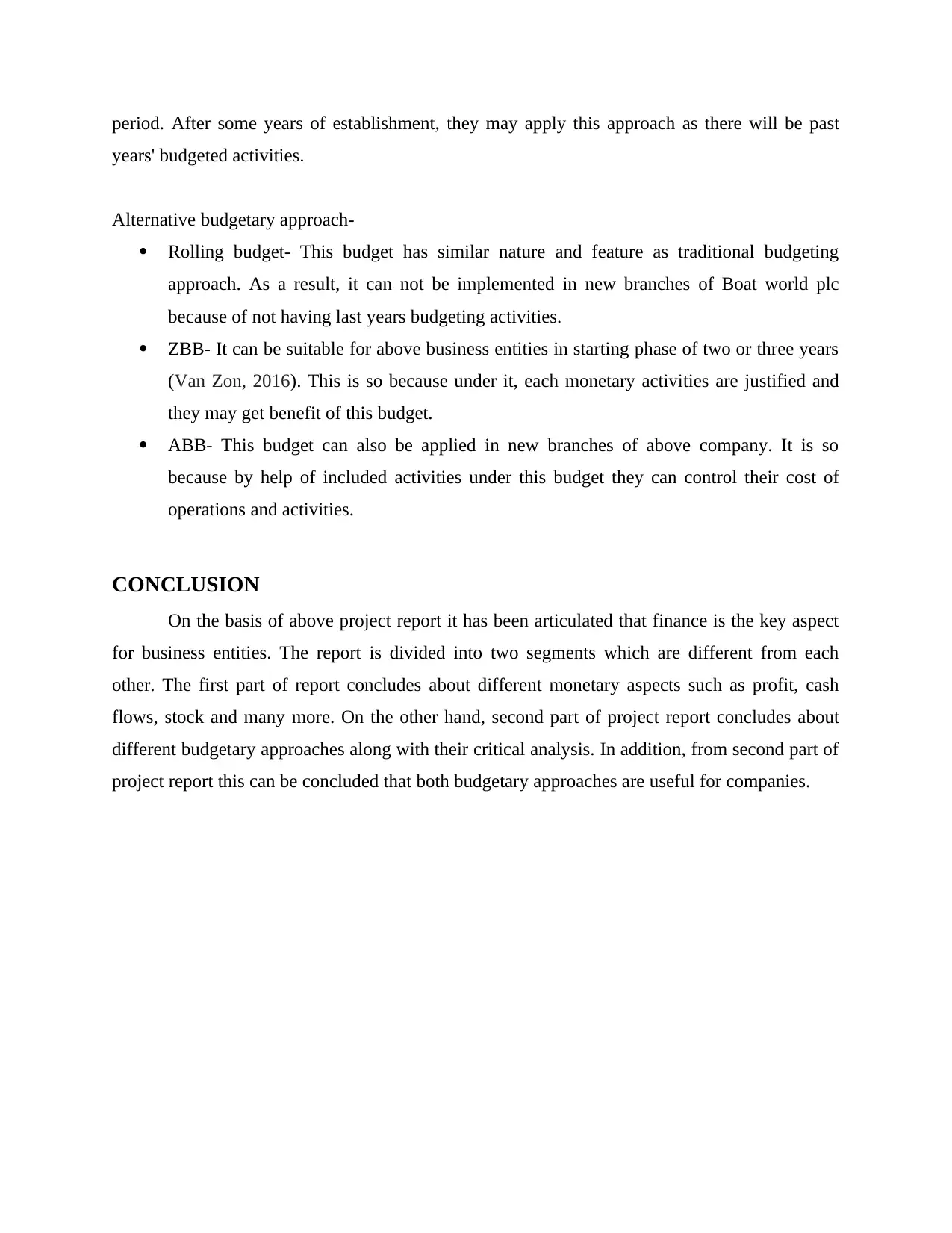
period. After some years of establishment, they may apply this approach as there will be past
years' budgeted activities.
Alternative budgetary approach-
Rolling budget- This budget has similar nature and feature as traditional budgeting
approach. As a result, it can not be implemented in new branches of Boat world plc
because of not having last years budgeting activities.
ZBB- It can be suitable for above business entities in starting phase of two or three years
(Van Zon, 2016). This is so because under it, each monetary activities are justified and
they may get benefit of this budget.
ABB- This budget can also be applied in new branches of above company. It is so
because by help of included activities under this budget they can control their cost of
operations and activities.
CONCLUSION
On the basis of above project report it has been articulated that finance is the key aspect
for business entities. The report is divided into two segments which are different from each
other. The first part of report concludes about different monetary aspects such as profit, cash
flows, stock and many more. On the other hand, second part of project report concludes about
different budgetary approaches along with their critical analysis. In addition, from second part of
project report this can be concluded that both budgetary approaches are useful for companies.
years' budgeted activities.
Alternative budgetary approach-
Rolling budget- This budget has similar nature and feature as traditional budgeting
approach. As a result, it can not be implemented in new branches of Boat world plc
because of not having last years budgeting activities.
ZBB- It can be suitable for above business entities in starting phase of two or three years
(Van Zon, 2016). This is so because under it, each monetary activities are justified and
they may get benefit of this budget.
ABB- This budget can also be applied in new branches of above company. It is so
because by help of included activities under this budget they can control their cost of
operations and activities.
CONCLUSION
On the basis of above project report it has been articulated that finance is the key aspect
for business entities. The report is divided into two segments which are different from each
other. The first part of report concludes about different monetary aspects such as profit, cash
flows, stock and many more. On the other hand, second part of project report concludes about
different budgetary approaches along with their critical analysis. In addition, from second part of
project report this can be concluded that both budgetary approaches are useful for companies.
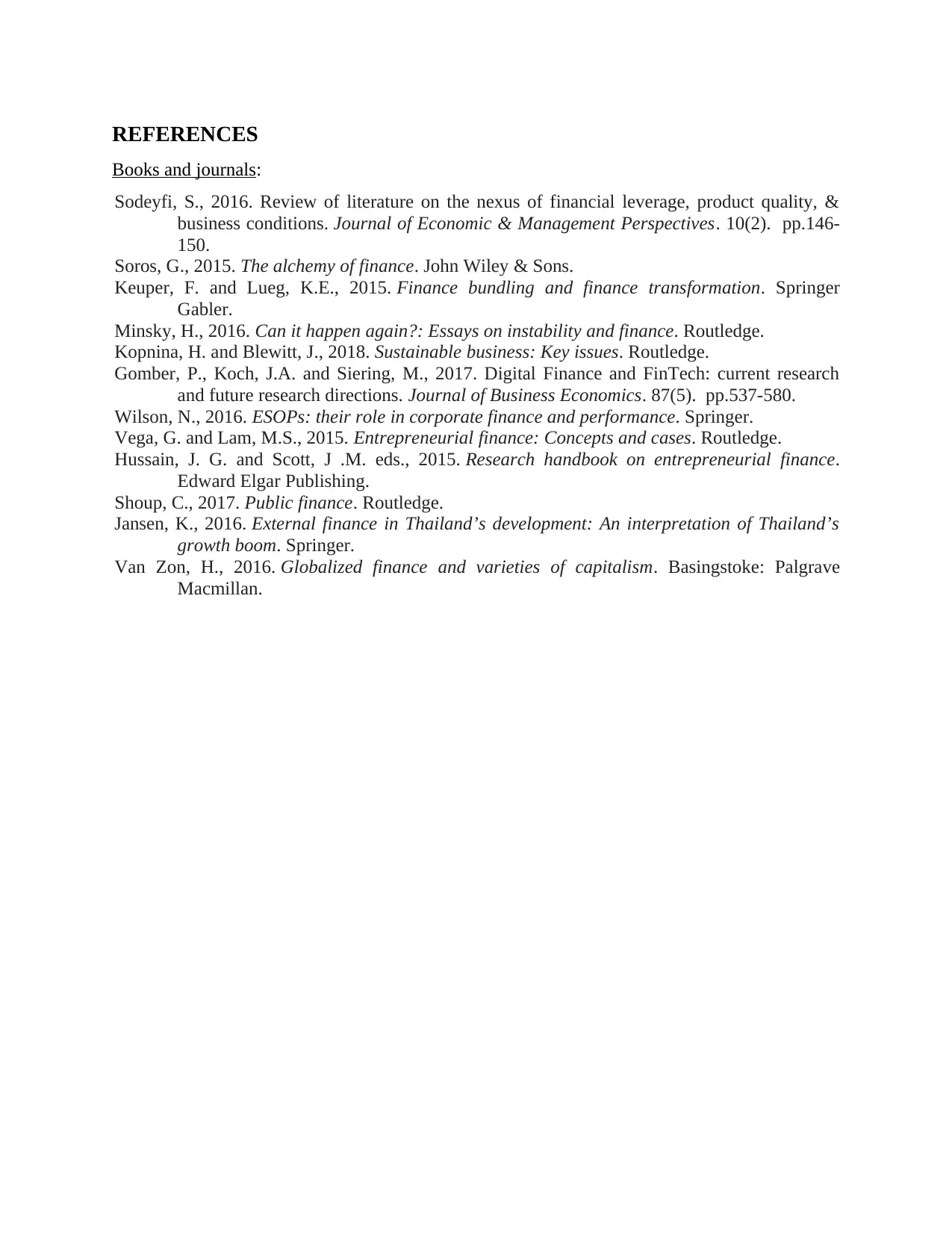
REFERENCES
Books and journals:
Sodeyfi, S., 2016. Review of literature on the nexus of financial leverage, product quality, &
business conditions. Journal of Economic & Management Perspectives. 10(2). pp.146-
150.
Soros, G., 2015. The alchemy of finance. John Wiley & Sons.
Keuper, F. and Lueg, K.E., 2015. Finance bundling and finance transformation. Springer
Gabler.
Minsky, H., 2016. Can it happen again?: Essays on instability and finance. Routledge.
Kopnina, H. and Blewitt, J., 2018. Sustainable business: Key issues. Routledge.
Gomber, P., Koch, J.A. and Siering, M., 2017. Digital Finance and FinTech: current research
and future research directions. Journal of Business Economics. 87(5). pp.537-580.
Wilson, N., 2016. ESOPs: their role in corporate finance and performance. Springer.
Vega, G. and Lam, M.S., 2015. Entrepreneurial finance: Concepts and cases. Routledge.
Hussain, J. G. and Scott, J .M. eds., 2015. Research handbook on entrepreneurial finance.
Edward Elgar Publishing.
Shoup, C., 2017. Public finance. Routledge.
Jansen, K., 2016. External finance in Thailand’s development: An interpretation of Thailand’s
growth boom. Springer.
Van Zon, H., 2016. Globalized finance and varieties of capitalism. Basingstoke: Palgrave
Macmillan.
Books and journals:
Sodeyfi, S., 2016. Review of literature on the nexus of financial leverage, product quality, &
business conditions. Journal of Economic & Management Perspectives. 10(2). pp.146-
150.
Soros, G., 2015. The alchemy of finance. John Wiley & Sons.
Keuper, F. and Lueg, K.E., 2015. Finance bundling and finance transformation. Springer
Gabler.
Minsky, H., 2016. Can it happen again?: Essays on instability and finance. Routledge.
Kopnina, H. and Blewitt, J., 2018. Sustainable business: Key issues. Routledge.
Gomber, P., Koch, J.A. and Siering, M., 2017. Digital Finance and FinTech: current research
and future research directions. Journal of Business Economics. 87(5). pp.537-580.
Wilson, N., 2016. ESOPs: their role in corporate finance and performance. Springer.
Vega, G. and Lam, M.S., 2015. Entrepreneurial finance: Concepts and cases. Routledge.
Hussain, J. G. and Scott, J .M. eds., 2015. Research handbook on entrepreneurial finance.
Edward Elgar Publishing.
Shoup, C., 2017. Public finance. Routledge.
Jansen, K., 2016. External finance in Thailand’s development: An interpretation of Thailand’s
growth boom. Springer.
Van Zon, H., 2016. Globalized finance and varieties of capitalism. Basingstoke: Palgrave
Macmillan.
⊘ This is a preview!⊘
Do you want full access?
Subscribe today to unlock all pages.

Trusted by 1+ million students worldwide
1 out of 12
Related Documents
Your All-in-One AI-Powered Toolkit for Academic Success.
+13062052269
info@desklib.com
Available 24*7 on WhatsApp / Email
![[object Object]](/_next/static/media/star-bottom.7253800d.svg)
Unlock your academic potential
Copyright © 2020–2025 A2Z Services. All Rights Reserved. Developed and managed by ZUCOL.





